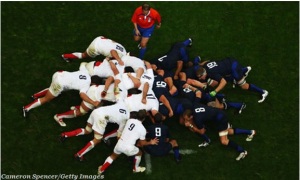 Standing in the middle of a training field recently, working with correcting the mechanics, rather than the technique, of a kicker with the aim of preventing abnormal wear and tear of the lower joints, I struggled not to be distracted by the forwards.
Standing in the middle of a training field recently, working with correcting the mechanics, rather than the technique, of a kicker with the aim of preventing abnormal wear and tear of the lower joints, I struggled not to be distracted by the forwards.
I love all disciplines of rugby but 15s is where I started and being within close proximity of a well-built pack in action still stirs the excitement within me. It starts from the ground and works its way up through the top of my head in the same way as a steam locomotive or bull running would do. I am aware of the power with every sense of the body; the forces are awe inspiring.
 However, as a biomechanist, the individual players become invisible and all I see is a collection of ‘shapes’. It is hard to explain but if the shape is ‘right’ then all is right with the World. In the same way that a square has four, equal length, straight sides and four 90° angles, so each shape in the scrum must fit its description. If the shape is incorrect, then it is safe to assume that the stability of the spine is jeopardized.
However, as a biomechanist, the individual players become invisible and all I see is a collection of ‘shapes’. It is hard to explain but if the shape is ‘right’ then all is right with the World. In the same way that a square has four, equal length, straight sides and four 90° angles, so each shape in the scrum must fit its description. If the shape is incorrect, then it is safe to assume that the stability of the spine is jeopardized.
As you can see from the photo on the left, the spine consists of four natural, distinct curves; giving it a soft ‘S’ shape, which act as a spring to distribute the force during activity and cope with applied gravity. These curves are vitally important and all but one have formed during growth and development after birth. They are also essential for maintaining balance and the reason we can stand upright.
As you can imagine, force is not only applied from above but during scrummaging, from either end. Imagine the position of the tight head prop who finds himself in the middle of two opposing forces acting to compress the discs between the vertebrae. If the natural curves were not present, the prop would be in trouble and at risk of something giving; dislodged discs or possible fractures!
The only way to maintain these curves is by having a flat back; closing down the shoulder blades and pointing the glutes skyward… part of the ‘shape’ I am looking for! More often than not in the amateur sport, it is the lumbar lordotic (inward) curve that is missing, causing lower back pain.
It should be remembered that even if the back is flat and presenting good curves, there is still a compression, notwithstanding the changing scrum laws, which can affect the soft tissue.
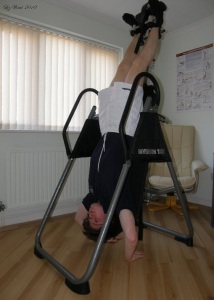 Aches and pains in the back, in general, should not be ignored as this will often lead to chronic issues. Back pain is so misunderstood and I sigh when I hear people are told that there is no treatment and they must ‘grin and bear it’ with a pack of meds. A good session with a soft tissue therapist will not just provide physical benefits, such as stretching; improving elasticity, improving circulation, increasing permeability and breaking down scar tissue but also physiological benefits by relaxing and reducing pain, as well as psychological benefits by being invigorating and reducing anxiety.
Aches and pains in the back, in general, should not be ignored as this will often lead to chronic issues. Back pain is so misunderstood and I sigh when I hear people are told that there is no treatment and they must ‘grin and bear it’ with a pack of meds. A good session with a soft tissue therapist will not just provide physical benefits, such as stretching; improving elasticity, improving circulation, increasing permeability and breaking down scar tissue but also physiological benefits by relaxing and reducing pain, as well as psychological benefits by being invigorating and reducing anxiety.
I have found inversion therapy works extremely well with all forwards, not just the front row. Gravity boots can be used but I prefer the safety of the Inversion Table. This anchors the ankles whilst upright and slowly inverts; allowing the table to be tethered at different angles, depending on the degree of discomfort in the back.
For maintenance purposes and general decompression of the vertebrae and discs, hanging completely upside down with hands off the floor allows gravity to help lengthen the spine and surrounding soft tissue.
Look after your back; watch your shapes and make like a bat!
Liz Ward








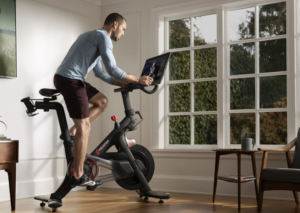 When most people hear the word “Peloton” they think of an expensive black bike with shiny red buttons and that controversial commercial where the husband gifted his wife a Peloton for Christmas.
When most people hear the word “Peloton” they think of an expensive black bike with shiny red buttons and that controversial commercial where the husband gifted his wife a Peloton for Christmas.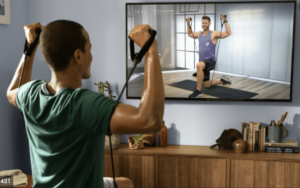 If the app interests you, Peloton is currently offering a 30 day FREE TRIAL, so why not give it a try? Check it out
If the app interests you, Peloton is currently offering a 30 day FREE TRIAL, so why not give it a try? Check it out 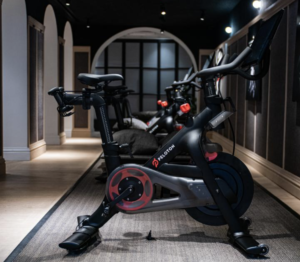
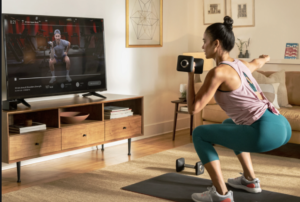
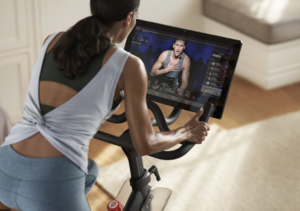 This article would not be complete, however, if we did not acknowledge some of the delivery issues that have been plaguing Peloton over the last year. Most of the delivery issues seem to affect U.S. deliveries, however, the UK deliveries have been affected as well.
This article would not be complete, however, if we did not acknowledge some of the delivery issues that have been plaguing Peloton over the last year. Most of the delivery issues seem to affect U.S. deliveries, however, the UK deliveries have been affected as well.







